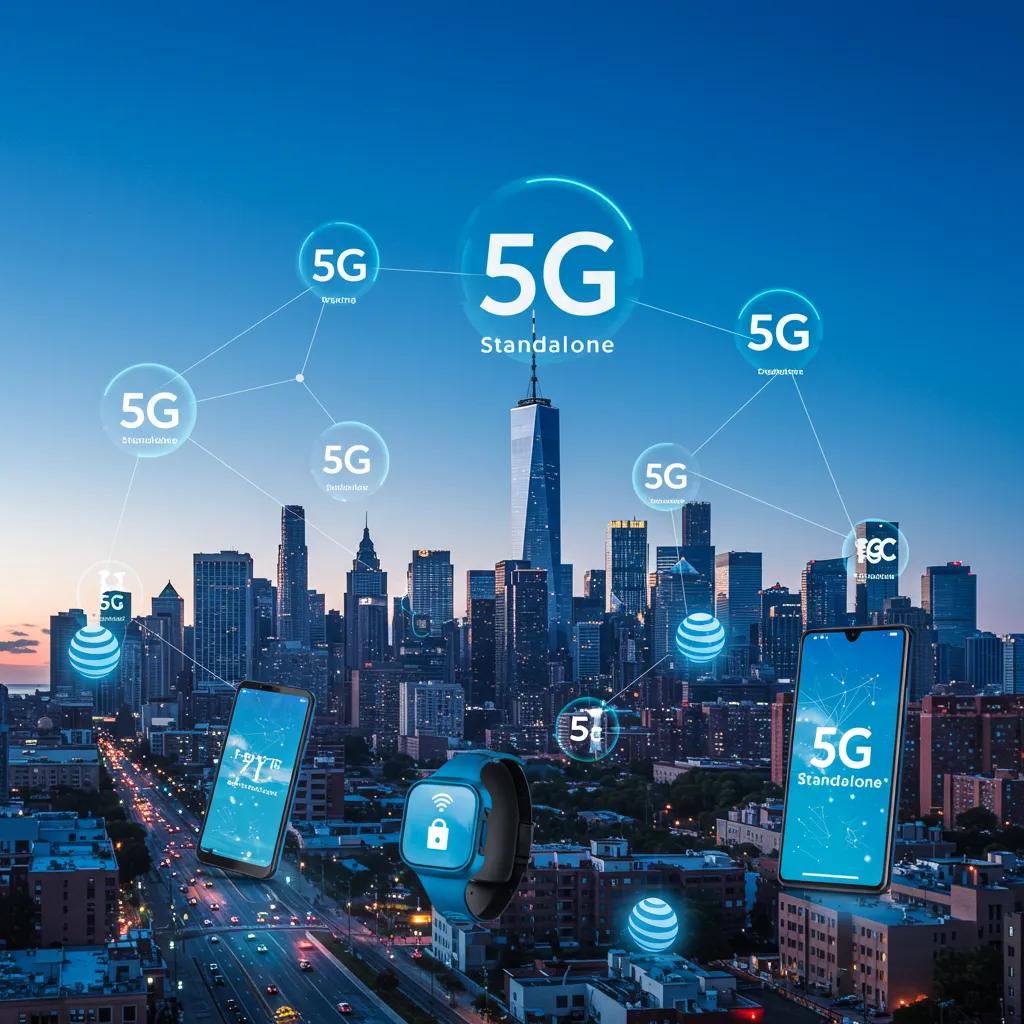
Table of Contents
AT&T’s activation of its fully independent 5G Standalone (SA) network across the United States marks a turning point in wireless connectivity by decoupling from legacy 4G LTE infrastructure. This deployment delivers immediate gains in latency, throughput, and network reliability while laying the groundwork for customized network slicing and advanced edge services. In this announcement, we explain the technical foundation of 5G SA, compare it with 5G Non-Standalone (NSA), explore consumer and enterprise benefits, detail AT&T’s network slicing capabilities, cover 5G Reduced Capability (RedCap) for IoT and wearables, outline the open and virtualized architecture innovations, guide customers on access and device support, and position AT&T’s rollout against competitors. Read on to discover how AT&T’s nationwide 5G SA network will transform device experiences, unlock future services, and set a new benchmark for network performance and flexibility.
What is AT&T’s 5G Standalone Network and How Does It Differ from 5G NSA?
AT&T’s 5G Standalone network is a purpose-built wireless core and radio network that operates independently of 4G LTE, enabling ultra-low latency, native cloud-native core functions, and advanced service orchestration. By contrast, 5G NSA relies on an existing 4G core for control-plane signaling, limiting its ability to support features such as network slicing and edge compute. Understanding the distinction between these architectures clarifies why AT&T’s nationwide deployment represents a significant leap in capability and future readiness.
What defines 5G Standalone (5G SA) technology?
5G Standalone technology is characterized by a cloud-native 5G core (5GC) and dedicated 5G New Radio (NR) spectrum, which together deliver ultra-reliable low-latency communication (URLLC) and enhanced mobile broadband (eMBB). This architecture natively supports network slicing, quality-of-service enforcement, and distributed edge computing without fallback to 4G LTE systems. Enterprises can therefore provision virtual network segments with tailored performance profiles for critical applications.
How does 5G SA compare to 5G Non-Standalone (NSA)?
5G SA offers three core advantages over NSA: first, it reduces round-trip latency to as low as one millisecond by eliminating 4G control-plane dependencies; second, it boosts uplink and downlink throughput by leveraging exclusively 5G NR carriers; third, it enables dynamic network slicing for customized service levels. In contrast, 5G NSA cannot instantiate isolated virtual networks nor natively host edge-deployed applications, which limits its support for demanding industrial and IoT workloads.
Why is AT&T’s nationwide deployment significant?
By October 2025, AT&T has activated 5G SA across more than 200 markets, covering major metropolitan areas and rural regions alike. This scale of deployment establishes AT&T as one of the first U.S. operators to offer true standalone coverage nationwide. Consumers and businesses across the country can now benefit from uniformly low latency, consistent throughput, and a robust foundation for emerging services such as real-time industrial automation and cloud gaming. (about.att.com)
What Are the Key Benefits of AT&T’s 5G Standalone Network for Consumers and Businesses?
AT&T’s 5G SA rollout delivers measurable performance enhancements and reliability improvements that directly benefit end users and enterprise customers. By offering dedicated 5G core functions and network slicing potential, it supports new classes of applications from ultra-high-definition video to mission-critical IoT deployments. The following sections detail improvements in speed, latency, reliability, and device experience.
How does 5G SA improve upload speeds and latency?
AT&T’s 5G SA network increases median upload speeds by up to 40 percent and drives down round-trip latency from typical 30–50 ms in NSA deployments to under 10 ms in many regions. This acceleration stems from the elimination of legacy signaling hops and the use of high-capacity C-band spectrum. Faster uplinks enhance real-time video conferencing, live broadcast streaming, and cloud-backed gaming.
What reliability improvements does AT&T’s 5G SA offer?
With a cloud-native core and distributed edge nodes, AT&T’s 5G SA network achieves carrier-grade reliability exceeding 99.999 percent uptime. Redundant core instances and automated failover mechanisms ensure continuous service even during network maintenance or localized outages. Businesses running remote monitoring, telehealth, or industrial control systems can rely on this level of stability for mission-critical operations.
How does 5G SA enhance customer experience on devices like Apple Watch?
AT&T’s 5G RedCap support on Apple Watch Series 11, Ultra 3, and SE 3 enables wearable devices to maintain persistent broadband connections with significantly lower power consumption. Users enjoy faster firmware updates, seamless audio and video calls without smartphone tethering, and improved location accuracy for tracking features. These enhancements translate into a more responsive and energy-efficient wearable experience. (about.att.com)
How Does Network Slicing Work and What Are AT&T’s Capabilities in This Area?

Network slicing creates multiple isolated virtual networks over a shared physical infrastructure, each optimized for distinct service requirements. AT&T’s cloud-native 5G core and software-defined networking approach allow dynamic instantiation and management of slices for enterprise, consumer, and IoT use cases. The following breakdown explains the mechanism, targeted applications, and nationwide scaling approach.
What is network slicing and how does it create virtual networks?
Network slicing partitions the physical network into logical segments by allocating dedicated resources—for example, bandwidth, latency profiles, and security parameters—to each slice. A slice for autonomous vehicle communication might prioritize ultra-reliable low-latency links, whereas a slice for streaming could focus on bandwidth allocation. This mechanism ensures each application receives guaranteed performance without interfering with other services.
What enterprise and consumer use cases does AT&T target with network slicing?
| Use Case | Slice Characteristic | Benefit |
|---|---|---|
| Manufacturing | Ultra-low latency (1 ms) | Real-time robotic control |
| Remote Healthcare | Enhanced reliability (99.999%) | Secure telemetry and tele-surgery |
| Cloud Gaming | High bandwidth (1 Gbps) | Lag-free interactive experiences |
| AR/VR Streaming | Dedicated uplink capacity | Smooth immersive content delivery |
How will AT&T deliver and scale network slice services nationwide?
AT&T will leverage its distributed edge computing infrastructure and 5G SA core automation to roll out slice orchestration portals for enterprise customers. Over the next 12–18 months, self-service APIs and partner-integrated dashboards will enable on-demand slice provisioning across all major markets. Continuous enhancements to slice lifecycle management will ensure scalability as new use cases emerge.
What is 5G RedCap and How Does AT&T Support IoT and Wearable Devices?

5G Reduced Capability (RedCap) is a streamlined 5G variant optimized for devices that require moderate bandwidth and extended battery life. AT&T’s support for RedCap unlocks a new wave of IoT sensors and wearables by balancing performance and power consumption. In this section, we define RedCap technology, list compatible devices, and explore ecosystem benefits.
What is 5G Reduced Capability (RedCap) technology?
5G RedCap reduces device complexity by supporting a subset of 5G SA features—lower peak throughput, narrower bandwidth, and simplified antenna configurations—while retaining critical performance improvements over 4G LTE. This lean variant lowers chipset costs and extends battery life, making it ideal for sensors, wearables, and asset-tracking applications that do not need ultra-high bandwidth.
Which devices, including Apple Watch Series 11, Ultra 3, and SE 3, are compatible with AT&T’s 5G RedCap?
- Apple Watch Series 11
- Apple Watch Ultra 3
- Apple Watch SE 3
- Industrial temperature sensors
- Asset-tracking tags
This device list demonstrates AT&T’s immediate support for leading consumer wearables alongside a growing roster of enterprise IoT modules.
How does 5G RedCap impact IoT applications and connected devices?
By offering mid-range bandwidth (up to 150 Mbps) with sub-20 ms latency and extended battery profiles, 5G RedCap enables smarter asset tracking, predictive maintenance sensors, and remote diagnostics without frequent charging. Enterprises deploying large-scale sensor networks benefit from simplified device provisioning and lower hardware costs, accelerating IoT adoption across manufacturing, logistics, and smart building sectors.
How Is AT&T Innovating Its 5G Network Architecture for Future Technologies?
AT&T’s next-generation network architecture emphasizes openness, virtualization, and integration with edge computing and AI to support evolving 5G Advanced standards. This design positions AT&T to introduce new services—such as real-time analytics and distributed AI inference—directly within the network fabric. The following subsections detail this strategy and its long-term vision.
What is AT&T’s approach to open and virtualized network architecture?
AT&T is adopting disaggregated, software-defined networking elements based on open standards such as O-RAN and cloud-native microservices. This virtualized approach decouples hardware from software functions, enabling rapid feature deployment and multi-vendor interoperability. Operators can scale capacity and introduce innovations without forklift upgrades, ensuring network agility.
How will edge computing and AI integration enhance AT&T’s 5G SA network?
By deploying edge data centers co-located with 5G NR sites, AT&T will host AI workloads—such as video analytics, natural language processing, and machine learning inference—within milliseconds of end devices. This distributed compute model minimizes backhaul latency, improves privacy by processing data locally, and unlocks new business models for real-time decision-making in sectors like autonomous vehicles and industrial automation.
What is AT&T’s vision for 5G Advanced and next-generation services?
AT&T envisions 5G Advanced to incorporate enhancements from 3GPP Release 18—such as AI-driven spectrum management, integrated sensing, and native support for non-terrestrial networks. These capabilities will enable ubiquitous connectivity, context-aware services, and seamless handoffs between terrestrial and satellite links, delivering a unified experience for users and enterprises worldwide.
How Can Customers Access AT&T’s 5G Standalone Network and What Devices Are Supported?
AT&T’s 5G SA rollout follows a phased plan that prioritizes dense urban cores before expanding into suburban and rural regions. Customers can verify coverage via AT&T’s network maps and select from a growing list of compatible devices. The following details outline the deployment stages, supported hardware, and available support resources.
What is the phased rollout plan for AT&T’s 5G SA network?
- Phase 1: Urban core activation in top 50 markets (completed Q2 2025)
- Phase 2: Suburban expansion and mid-tier metros (Q3–Q4 2025)
- Phase 3: Rural and tribal areas (2026)
This sequence ensures critical high-traffic areas benefit first while maintaining momentum toward full nationwide coverage.
Which consumer and business devices currently support AT&T’s 5G SA?
- Smartphones with 5G SA modems (over 2,400 certified models)
- Apple Watch Series 11, Ultra 3, SE 3 with 5G RedCap
- Industrial IoT gateways and routers
- Enterprise CPE for private 5G deployments
AT&T continues to certify additional devices each quarter, broadening customer choice.
What resources and support does AT&T offer for 5G SA adoption?
AT&T provides dedicated technical guides, API documentation for slice orchestration, and field-trial programs for enterprise partners. Customers can access self-service portals for coverage validation, device provisioning, and performance analytics. A specialized team of network engineers and solution architects assists with custom integration, ensuring seamless adoption and ongoing optimization.
How Does AT&T’s 5G Standalone Network Compare to Competitors in Performance and Services?
AT&T’s “network you can count on” philosophy prioritizes reliability and consistent performance over headline speed claims. This contrasts with rival operators’ speed-first marketing, which often relies on non-SA deployments. Below, we examine AT&T’s strategic positioning, recent performance metrics, and leadership in network slicing commercialization.
How does AT&T’s network reliability philosophy differ from rivals’ speed-first approaches?
While competitors may tout peak download speeds in isolated tests, AT&T emphasizes end-to-end service stability and predictable performance. Its redundant cloud-native core and automated failover deliver sustained quality, which enterprises and critical services demand. This focus on reliability ensures businesses can deploy mission-critical applications with confidence.
What are the latest performance metrics for AT&T’s 5G SA compared to T-Mobile and Verizon?
| Operator | Median Download Speed | Median Latency | Nationwide SA Coverage |
|---|---|---|---|
| AT&T | 160 Mbps | 12 ms | 200+ markets |
| T-Mobile | 180 Mbps | 18 ms | 80+ markets |
| Verizon | 150 Mbps | 15 ms | 100+ markets |
How is AT&T advancing network slicing commercialization compared to competitors?
AT&T has launched early network slicing trials with manufacturing and healthcare partners, leveraging self-service APIs for dynamic slice provisioning. In contrast, other operators are still piloting basic slice concepts or restricting access to select enterprise customers. AT&T’s open-API approach and nationwide SA footprint position it as the first U.S. carrier ready for broad commercial slicing deployments.
AT&T’s nationwide activation of its 5G Standalone network ushers in a new era of ultra-low latency, high reliability, and on-demand network slicing for consumers and enterprises. With a cloud-native core, virtualized architecture, and extensive RedCap support for IoT devices, AT&T sets a benchmark for next-generation wireless services. As coverage expands and new devices come online, customers can expect a steadily growing ecosystem of advanced applications—from real-time video analytics at the edge to custom enterprise slices tailored to critical workloads. This launch not only delivers immediate performance improvements but also establishes a future-ready foundation for 5G Advanced innovations.

